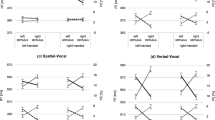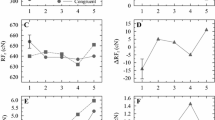Abstract
Sebanz et al. (Cognition 88:B11–B21, 2003) have shown that spatial correspondence effects are observed even when the two-choice reaction time task is distributed between two people, such that each person is assigned only one of two possible stimulus–response (S–R) pairings. The effect is similar to when one person is assigned and responds to both S–R pairings. These results have been taken to suggest that two people performing a complementary task co-represent each other’s response alternatives. In our experiment, we examined performance when paired participants responded to the same S–R alternative. We reasoned that co-representation would be of little advantage as the task alternatives would be the same for both participants. Correspondence effects were absent when paired participants responded to the same S–R alternative but emerged when they responded to different alternatives.

Similar content being viewed by others
Notes
Guagnano et al. (2009) have recently shown that a similar spatial correspondence effect may also be obtained in a situation in which two participants simultaneously, but independently, perform non-complementary simple RT tasks. These authors propose that when the participants perform a non-collaborative task, the presence of between-person spatial correspondence effects may be a result of the spatial coding induced by the presence of a second participant. That is, the presence of another person might provide a reference for the spatial coding of one’s own action. Correspondence effects are then thought to arise as a result of this spatial coding, and not necessarily from the shared representation of the other person’s actions.
References
Ansorge, U., & Wühr, P. (2004). A response-discrimination account of the Simon effect. Journal of Experimental Psychology: Human Perception and Performance, 30, 365–377.
Ansorge, U., & Wühr, P. (2009). Transfer of response codes from choice-response to go/no-go tasks. The Quarterly Journal of Experimental Psychology, 62, 1216–1235.
Guagnano, D., Rusconi, E., & Umiltà, C. A. (2009). Sharing a task or sharing space? On the effect of the confederate in action coding in a detection task. Cognition. doi:10.1016/j.cognition.2009.10.008.
Knoblich, G., & Sebanz, N. (2006). The social nature of perception and action. Current Directions in Psychological Science, 15, 99–104.
Sebanz, N., Bekkering, H., & Knoblich, G. (2006). Joint actions: bodies and minds moving together. Trends in Cognitive Sciences, 10, 70–76.
Sebanz, N., Knoblich, G., & Prinz, W. (2003). Representing others’ actions: Just like one’s own? Cognition, 88, B11–B21.
Sebanz, N., Knoblich, G., & Prinz, W. (2005a). How two share a task: Corepresenting stimulus–response mappings. Journal of Experimental Psychology: Human Perception and Performance, 31, 1234–1246.
Sebanz, N., Knoblich, G., Stumpf, L., & Prinz, W. (2005b). Far from action blind: Representation of others’ actions in individuals with autism. Cognitive Neuropsychology, 22, 433–454.
Sebanz, N., Rebbechi, D., Knoblich, G., Prinz, W., & Frith, C. D. (2007). Is it really my turn? An event-related fMRI study of task sharing. Social Neuroscience, 2, 81–95.
Simon, J. R. (1969). Reactions towards the source of stimulation. Journal of Experimental Psychology, 81, 174–176.
Tsai, C., & Brass, M. (2007). Does the human motor system simulate Pinocchio’s actions? Coacting with a human hand versus a wooden hand in a dyadic interaction. Psychological Science, 18, 1058–1062.
Tsai, C., Kuo, W., Jing, J., Hung, D., & Tzeng, O. (2006). A common coding framework in self other inter-action. Evidence from a joint action task. Experimental Brain Research, 175, 353–362.
Welsh, T. N., Higgins, L., Ray, M., & Weeks, D. J. (2007). Seeing vs believing: Is believing sufficient to activate the processes of response co-representation? Human Movement Science, 26, 853–866.
Acknowledgments
We thank Sylvia Hua and Melissa Cory for their assistance with data collection. This research was supported by a grant from the Natural Sciences and Engineering Research Council of Canada (NSERC) awarded to RC and by a University Graduate Fellowship from the University of British Columbia awarded to MYL. We thank Drs Ian Franks and Nicola Hodges for their feedback on the study and manuscript, and Dr Timothy Welsh and two anonymous reviewers for their helpful reviews.
Author information
Authors and Affiliations
Corresponding author
Rights and permissions
About this article
Cite this article
Lam, M.Y., Chua, R. Influence of stimulus–response assignment on the joint-action correspondence effect. Psychological Research 74, 476–480 (2010). https://doi.org/10.1007/s00426-009-0269-4
Received:
Accepted:
Published:
Issue Date:
DOI: https://doi.org/10.1007/s00426-009-0269-4




